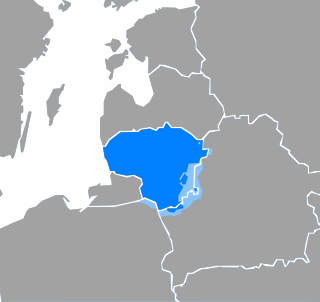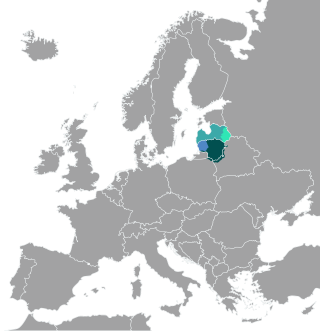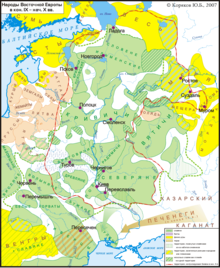
The Baltic languages are a branch of the Indo-European language family spoken natively or as a second language by a population of about 6.5–7.0 million people mainly in areas extending east and southeast of the Baltic Sea in Europe. Together with the Slavic languages, they form the Balto-Slavic branch of the Indo-European family.

The Balts or Baltic peoples are an ethno-linguistic group of peoples who speak the Baltic languages of the Balto-Slavic branch of the Indo-European languages.
Sudovian was a West Baltic language of Northeastern Europe. Sudovian was closely related to Old Prussian. It was formerly spoken southwest of the Nemunas river in what is now Lithuania, east of Galindia and in the north of Yotvingia, and by exiles in East Prussia.

Lithuanian is an East Baltic language belonging to the Baltic branch of the Indo-European language family. It is the official language of Lithuania and one of the official languages of the European Union. There are approximately 2.8 million native Lithuanian speakers in Lithuania and about 1,000,000 speakers elsewhere. Around half a million inhabitants of Lithuania of non-Lithuanian background speak Lithuanian daily as a second language.

The river Neris or Vilija rises in northern Belarus. It flows westward, passing through Vilnius and in the south-centre of that country it flows into the Nemunas (Neman), at Kaunas, as its main tributary. Its length is 510 km (320 mi).

Yotvingians were a Western Baltic people who were closely tied to the Old Prussians. The linguist Petras Būtėnas asserts that they were closest to the Lithuanians. The Yotvingians contributed to the formation of the Lithuanian state.

The Radimichs were an East Slavic tribe of the last several centuries of the 1st millennium, which inhabited upper east parts of the Dnieper down the Sozh and its tributaries. The name probably derives from the name of the forefather of the tribe - Radim. According to Russian chronicle tradition, "... but there were Radimichs from the Lechites family, who came and settled here and paid tribute to Rus, and the wagon was carried to the present day". However, in the scientific literature, there is no consensus on the ethnicity of the Radimichs. Archaeological evidence indicates that this tribal association had a mixed Slavic-Baltic origin.

The East Baltic languages are a group of languages that along with the extinct West Baltic languages belong to the Baltic branch of the Indo-European language family. The East Baltic branch has only four living languages—Latvian, Latgalian, Lithuanian, and Samogitian. It also includes now-extinct Selonian, Semigallian, and possibly Old Curonian.

Galindians were two distinct, and now extinct, tribes of the Balts. Most commonly, Galindians refers to the Western Galindians who lived in the southeast part of Prussia. Less commonly, it is used for a tribe that lived in the area of what is today Moscow.

The Nadruvians were a now-extinct Prussian tribe. They lived in Nadruvia, a large territory in northernmost Prussia. They bordered the Skalvians on the Neman (Nemunas) River just to the north, the Sudovians to the east, and other Prussian tribes to the south and west. Most information about the clan is provided in a chronicle by Peter von Dusburg.

The Zarubintsy, Zarubyntsi or Zarubinets culture was a culture that, from the 3rd century BC until the 1st century AD, flourished in the area north of the Black Sea along the upper and middle Dnieper and Pripyat Rivers, stretching west towards the Southern Bug river. Zarubintsy sites were particularly dense between the Rivers Desna and Ros as well as along the Pripyat river. It was identified around 1899 by the Czech-Ukrainian archaeologist Vikentiy Khvoyka and is now attested by about 500 sites. The culture was named after finds of cremated remains in the village of Zarubyntsi on the Dnieper.

Proto-Baltic is the unattested, reconstructed ancestral proto-language of all Baltic languages. It is not attested in writing, but has been partly reconstructed through the comparative method by gathering the collected data on attested Baltic and other Indo-European languages. It represents the common Baltic speech that approximately was spoken between the 3rd millennium BC and ca. 5th century BC, after which it began dividing into West and East Baltic languages. Proto-Baltic is thought to have been a fusional language and is associated with the Corded Ware and Trzciniec cultures.

Zigmas Zinkevičius was a Lithuanian academician, baltist, linguist, linguistic historian, dialectologist, politician, and the former Minister of Education and Science of Lithuania (1996–1998). Zinkevičius authored over a hundred books, including the popular six-volume "History of the Lithuanian language" (1984–1994), and over a thousand articles, both in Lithuanian and other languages. He was an academician of the Lithuanian Catholic Academy of Science since 1991 and a full member of the Lithuanian Academy of Sciences from 1990 to 2011, when he became an emeritus member.

The first known record of the name of Lithuania is in a 9 March 1009 story of Saint Bruno recorded in the Quedlinburg Chronicle. The Chronicle recorded a Latinized form of the Old Church Slavonic word for Lithuania — Литъва — Latinized as Litva. Although it is clear the name originated from a Baltic language, scholars still debate the meaning of the word.

The Western Baltic culture was the westernmost branch of the Balts, representing a distinct archaeological culture of the Bronze Age and Iron Age, along the southern coast of the Baltic Sea. It is a zone of several small archaeological cultures that were ethnically Baltic and had similar cultural features. They included tribes such as the Old Prussians, Galindians, Yotvingians and Skalvians, in addition to the little-known Pomeranian Balts or Western Balts proper, in the area now known as Pomerania.

The West Baltic languages are a group of extinct Baltic languages that were spoken by West Baltic peoples. West Baltic is one of the two primary branches of Baltic languages, along with East Baltic. It includes Old Prussian, Sudovian, West Galindian, possibly Skalvian and Old Curonian.

The Science and Encyclopaedia Publishing Centre is a Lithuanian publishing house that specializes in encyclopedias, reference works, and dictionaries. The Institute, headquartered in Vilnius, is supported by the Lithuanian Republic's Ministry of Education and Science.
In Lithuanian history, Sarmatism is a term used to refer to various nationalist pseudohistorical theories which seek to refute traditional understanding of the history of Lithuania and propose that the medieval Grand Duchy of Lithuania is a continuation of states and ethnic groups in Eastern Europe attested before the first mention of the name of Lithuania recorded in the Annals of Quedlinburg in 1009. The name comes from Sarmatia, a term used in Greco-Roman cartography, notably the Geography of Ptolemy, to label all of Eastern Europe, and which is generally believed by Sarmatist historians to refer to the extent of Antiquity-era Lithuania.
















